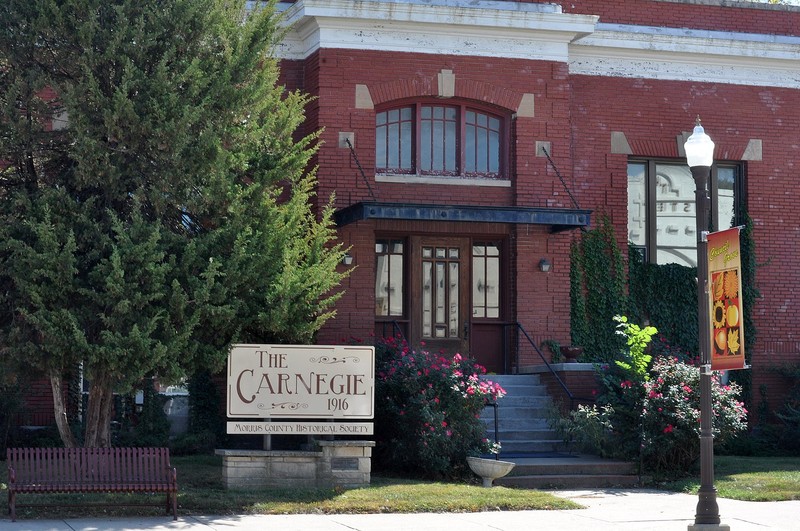Council Grove Carnegie Library
Introduction
Text-to-speech Audio
This historic library opened in 1917 thanks in part to a matching grant from Andrew Carnegie and public funds. Council Grove's library association formally organized in 1876 and submitted its grant proposal to the Carnegie Corporation in 1903, but it took organizers many years to secure the required matching funds and construct the now-historic library. Carnegie's road to his storied philanthropy included a long and complex relationship with the working class. For instance, an 1892 strike at one of Carnegie's mills culminated in hired "detectives" killing several striking workers. Later in life, Carnegie spent ninety percent of his fortune (more than $330 million in 1915 dollars) on community projects, including thousands of libraries. More than sixty of those Carnegie-funded libraries were built in Kansas, including the Council Grove Carnegie Library.
Images
Council Grove Carnegie Library

Backstory and Context
Text-to-speech Audio
The Council Grove Library Association, established in 1876, received the $10,000 Carnegie Library grant in 1903 and built the Neo-Classic library building in 1917. The historic library was one of sixty-three Cargenegie Libraries constructed in Kansas during the first three decades of the twentieth century.
An exceptionally wealthy industrialist, Andrew Carnegie (1835 -1919) enjoyed a complicated relationship with laborers and the lower class. In 1882, Carnegie and Henry Clay Frick colluded to beat down the striking steelworkers during the Homestead Steel Strike (workers sought better pay and improved working conditions), one of the worst labor conflicts in American history. Seven years later, in 1889, Carnegie wrote "The Gospel of Wealth." In the article, he explained spelled his views on philanthropy: "In bestowing charity the main consideration should be to help those who help themselves." His well-documented philanthropy amounted to $333 million (ninety percent of his fortune), most of which went to public buildings and community projects, which he deemed "the improvement of mankind." Much of his wealth went to building libraries. Indeed, more than $56 million of his wealth went to constructing more than 2,500 libraries. Though many of his laborers said, "What good is a book to a man who works 12 hours a day, six days a week?" Carnegie felt that raising wages would not help as workers would probably spend it on better food or drinks instead of what he thought they "needed."
Ultimately, The Carnegie Corporation significantly impacted the development and expansion of public library systems worldwide. Between 1886 and 1921, Carnegie funds assisted in the construction of 1,681 city and 108 college libraries in the United States. Kansas ranks approximately eleventh in the number of Carnegie Libraries built, with sixty-three Cargenegie Libraries erected in the state during the first three decades of the twentieth century.
Communities initiated contact with the Carnegie corporation indicating their desire for a Carnegie-funded library. The funds paid for the library construction while the town provided the money to pay for the building's maintenance. Thus, most Carnegie library projects involved both the grant request and voter support of a referendum in a public election.
Before 1910, the Carnegie Corporation did not provide design guidelines for the libraries that it funded because the library existed as a relatively new building type; few architects or builders had experience with its design. In 1910, Carnegie's personal secretary James Bertram developed model specifications and floor plans for proposed libraries, entitling his work Notes on Library Buildings. The Notes on Library Buildings provided the first widely circulated guidelines for library design in this country, such as a need for the librarian to oversee the library from a central position with the housing of books on the main floor, comfortable accommodations for reading them by adults and children, and a (basement) lecture room. The thirty-six Carnegie Libraries built in Kansas after 1910 reflect Bertram's library model.
Sources
Bobinski, George S. "Carnegie Libraries: Their History and Impact on American Public Library Development." ALA Bulletin 62, no. 11 (1968): 1361-367. http://www.jstor.org/stable/25698025.
Frankel, Noralee and Nancy S. Dye, eds. Gender, Class, Race, and Reform in the Progressive Era. Lexington: University Press of Kentucky, 1991.
Hagedorn, Martha Gray. "Nomination Form: Council Grove (Carnegie) Library." National Register of Historic Places. nps.gov. 1987. https://npgallery.nps.gov/GetAsset/7b5d6cfd-889f-48a3-a0a2-8bd028f0b93a.
Stamberg, Susan. "How Andrew Carnegie Turned His Fortune Into A Library Legacy." NPR.org. May 21, 2009. https://www.npr.org/2013/08/01/207272849/how-andrew-carnegie-turned-his-fortune-into-a-library-legacy.
Standiford, Les. Meet You in Hell: Andrew Carnegie, Henry Clay Frick, and the Bitter Partnership That Transformed America. New York: Crown, 2010.
By Art davis - Own work, CC BY-SA 3.0, https://commons.wikimedia.org/w/index.php?curid=44183127
